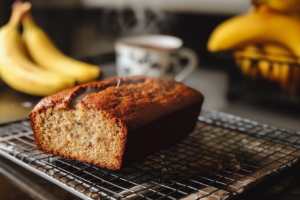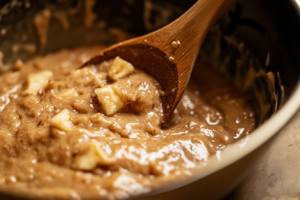Introduction
Bananas are a versatile and popular fruit in baking. From banana bread to muffins and cakes, they add natural sweetness and moisture to countless recipes. However, while bananas are usually a reliable baking ingredient, there are times when they may not be suitable for your recipe.
Knowing when not to use bananas for baking is just as important as knowing when to use them. Using the wrong bananas can affect the texture, flavor, and overall success of your baked goods. In this article, we’ll explore the key factors that determine when bananas aren’t suitable for baking, how to identify them, and what alternatives you can use.
How Banana Ripeness Affects Baking
The ripeness of bananas plays a critical role in how they perform in baked goods. Bananas change dramatically as they ripen, impacting both flavor and texture.
1. Overripe Bananas
Overripe bananas are ideal for most baking recipes. When bananas turn brown and spotty, their starches convert to sugar, giving them a sweeter taste and softer texture. This makes them perfect for moist, sweet treats like banana bread, cakes, and muffins.
However, extremely overripe bananas—those that are entirely black, mushy, or have an unpleasant smell—should be avoided. At this stage, bananas may be too far gone for baking, as they can negatively affect both flavor and texture. Overripe bananas that are fermented or have mold are also unsafe to use.
When to avoid overripe bananas:
- If they have a strong, fermented smell.
- If they are completely black with no firmness left.
- If mold is present.
2. Underripe Bananas
On the other end of the spectrum are underripe bananas. These bananas are green or pale yellow and have a firm, starchy texture. While underripe bananas are fine for snacking, they don’t work well in baking.
Underripe bananas lack the natural sweetness and moisture needed to enhance baked goods. Using them can result in a dry, less flavorful product, as they don’t break down and integrate with other ingredients as well as ripe bananas do.
When to avoid underripe bananas:
- If they are green or yellow with no brown spots.
- If they are firm to the touch and difficult to mash.
- If they have a mildly bitter taste due to unconverted starches.
3. Perfectly Ripe Bananas
For most baking recipes, perfectly ripe bananas—those that are yellow with brown spots—are the ideal choice. These bananas strike the right balance between sweetness and texture. They are easy to mash and incorporate into batters, ensuring a moist and flavorful result.
When to use perfectly ripe bananas:
- When they are yellow with brown spots.
- When they are soft but not mushy.
- When they have a strong banana aroma.
Other Factors to Consider Before Using Bananas for Baking
Bananas’ suitability for baking can depend on more than just ripeness. Several other factors should be considered to determine whether your bananas are appropriate for your recipe.
1. Bananas with Bruises or Damage
Bananas that are bruised or damaged can sometimes be used in baking, but only if the damage is minor. Large bruises or dark, mushy spots can indicate that parts of the banana have gone bad, which can affect the taste of your baked goods.
When to avoid bruised or damaged bananas:
- If large parts of the banana are discolored or soft.
- If there is a foul odor coming from the bruised area.
- If the banana flesh underneath the peel looks brown and slimy.
If the bruising is minor and the rest of the banana is in good condition, you can cut away the damaged part and use the rest for baking.
2. Bananas with Mold
Mold is a clear sign that bananas should not be used for baking. Mold can form on the peel or the flesh of bananas that are too old, indicating spoilage. Even if the mold is only on the peel, it’s better to discard the banana to avoid health risks.
When to avoid bananas with mold:
- If there are white, green, or black mold spots on the peel or inside the banana.
- If the banana smells sour or fermented.
3. Bananas with an Off Smell
Fresh bananas have a sweet, mild aroma. When bananas start to smell sour, fermented, or alcoholic, it’s a sign that they’ve begun to spoil. These bananas can ruin the taste of your baked goods and may even pose a health risk if they’ve started to ferment.
When to avoid bananas with an off smell:
- If they smell sour or like alcohol.
- If there is a strong, unpleasant odor coming from the peel or flesh.
Alternatives to Bananas in Baking
If you find that your bananas are not suitable for baking, don’t worry! There are plenty of alternative ingredients that can replicate the moisture, sweetness, and binding properties of bananas.
1. Applesauce
Applesauce is a great substitute for bananas in baking. It provides moisture and natural sweetness, making it an ideal replacement in cakes, muffins, and quick breads. Use 1/2 cup of applesauce for each banana that the recipe calls for.
2. Pumpkin Puree
Pumpkin puree works well in recipes that require a similar texture and moisture to bananas. It also adds a subtle flavor that pairs beautifully with spices like cinnamon and nutmeg. Replace each banana with 1/2 cup of pumpkin puree.
3. Mashed Avocado
For those seeking a healthy, creamy alternative, mashed avocado can be a great banana substitute. Its mild flavor and creamy texture work well in baked goods like brownies or cakes. Use 1/2 cup of mashed avocado for each banana.
4. Greek Yogurt
Greek yogurt adds moisture and richness to baked goods, making it another great option for replacing bananas. Opt for plain, unsweetened Greek yogurt, and use 1/4 to 1/2 cup of yogurt for each banana.
FAQs About Using Bananas in Baking
1. Can You Use Black Bananas for Baking?
Yes, you can use black bananas for baking, but only if they are not completely mushy or fermented. If the banana is soft, sweet, and has no mold or off smells, it can be used in recipes like banana bread or muffins.
2. Can You Bake with Green Bananas?
No, it’s best to avoid using green bananas in baking. They are too firm and starchy, which makes it difficult for them to blend into the batter and provide the necessary moisture and sweetness.
3. How Do You Know if Bananas Are Too Ripe for Baking?
Bananas are too ripe for baking if they are completely black, mushy, and have a strong fermented smell. If mold is present or the banana feels slimy, it should not be used.
4. What Can I Use If I Don’t Have Bananas for Baking?
If you don’t have bananas, you can substitute them with applesauce, pumpkin puree, mashed avocado, or Greek yogurt. These ingredients will provide similar moisture and texture to your baked goods.
Conclusion
Bananas are an excellent ingredient for baking, but not all bananas are created equal when it comes to achieving the best results. Knowing when not to use bananas for baking is crucial to ensuring the quality of your baked goods. Overripe bananas are perfect for most recipes, but bananas that are too mushy, fermented, or moldy should be avoided. Similarly, underripe bananas lack the sweetness and moisture needed for successful baking.
If your bananas aren’t suitable for baking, there are many alternatives like applesauce, pumpkin puree, mashed avocado, and Greek yogurt that can easily replace bananas in most recipes. By understanding the right time to use bananas—and when to skip them—you can ensure your baked goods turn out moist, flavorful, and delicious every time.
For more baking tips and recipes, check out our lunch category here. You can also learn more about bananas and their uses in baking by visiting the banana Wikipedia page.



